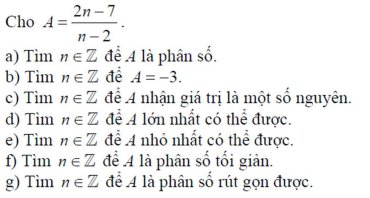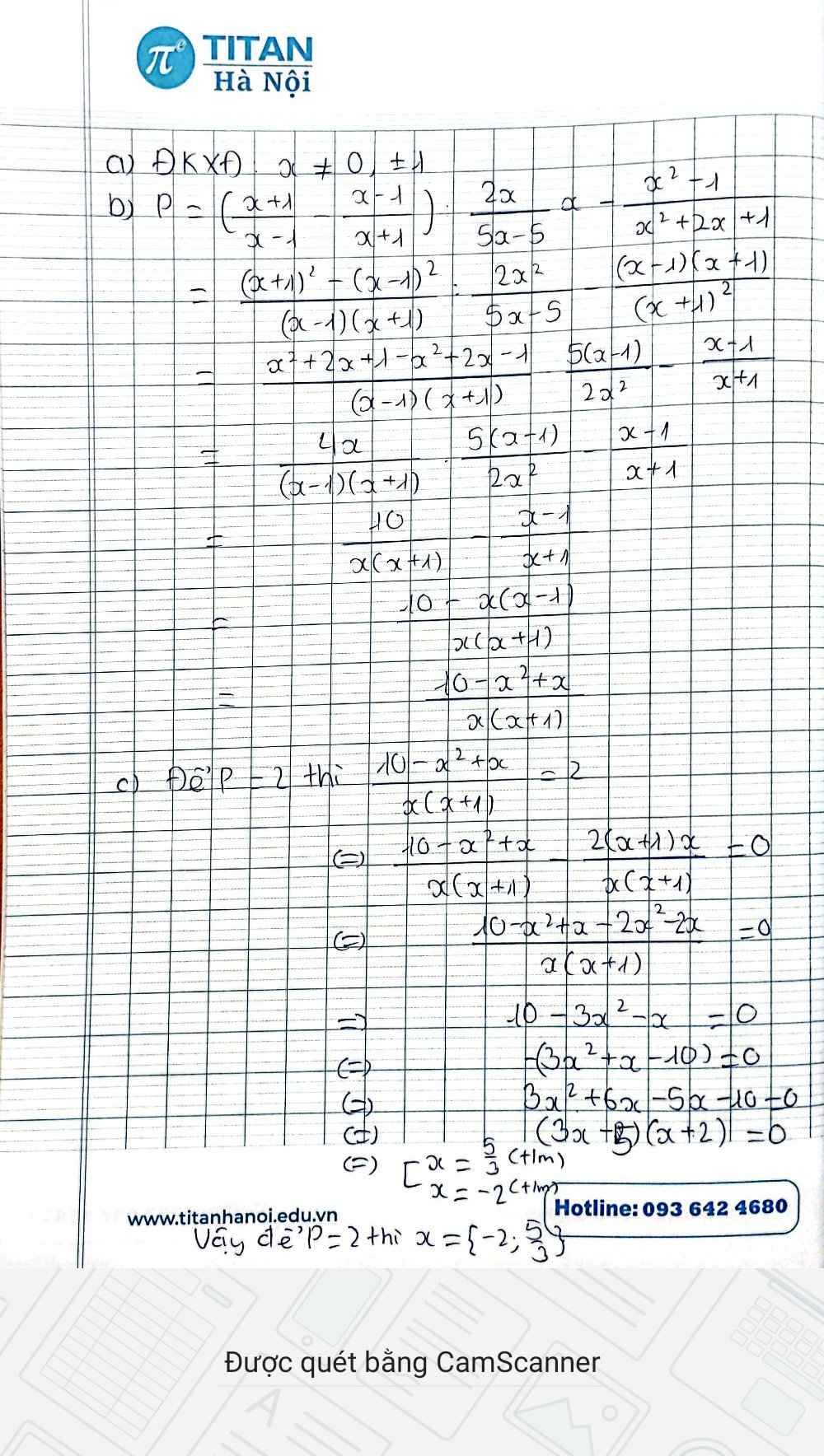 Help!
Help!
Hãy nhập câu hỏi của bạn vào đây, nếu là tài khoản VIP, bạn sẽ được ưu tiên trả lời.


Dài quá trôi hết đề khỏi màn hình: nhìn thấy câu nào giải cấu ấy
Bài 4:
\(A=\frac{\left(x-1\right)+\left(x+1\right)}{\left(x+1\right)\left(x-1\right)}-\frac{2}{\left(x+1\right)\left(x-1\right)}=\frac{2\left(x-1\right)}{\left(x-1\right)\left(x+1\right)}\)
a) DK x khác +-1
b) \(dk\left(a\right)\Rightarrow A=\frac{2}{\left(x+1\right)}\)
c) x+1 phải thuộc Ước của 2=> x=(-3,-2,0))
1. a) Biểu thức a có nghĩa \(\Leftrightarrow\hept{\begin{cases}x+2\ne0\\x^2-4\ne0\end{cases}}\)
\(\Leftrightarrow\hept{\begin{cases}x+2\ne0\\x-2\ne0\\x+2\ne0\end{cases}}\)
\(\Leftrightarrow\hept{\begin{cases}x\ne-2\\x\ne2\end{cases}}\)
Vậy vs \(x\ne2,x\ne-2\) thì bt a có nghĩa
b) \(A=\frac{x}{x+2}+\frac{4-2x}{\left(x-2\right)\left(x+2\right)}\)
\(=\frac{x\left(x-2\right)}{\left(x+2\right)\left(x-2\right)}+\frac{4-2x}{\left(x+2\right)\left(x-2\right)}\)
\(=\frac{x^2-2x+4-2x}{\left(x+2\right)\left(x-2\right)}\)
\(=\frac{x^2-4x+4}{\left(x+2\right)\left(x-2\right)}\)
\(=\frac{\left(x-2\right)^2}{\left(x+2\right)\left(x-2\right)}\)
\(=\frac{x-2}{x+2}\)
c) \(A=0\Leftrightarrow\frac{x-2}{x+2}=0\)
\(\Leftrightarrow x-2=\left(x+2\right).0\)
\(\Leftrightarrow x-2=0\)
\(\Leftrightarrow x=2\)(ko thỏa mãn điều kiện )
=> ko có gía trị nào của x để A=0

a: \(=\dfrac{2x-9-x^2+9+2x^2-4x+x-2}{\left(x-3\right)\left(x-2\right)}\)
\(=\dfrac{x^2-x-2}{\left(x-3\right)\left(x-2\right)}=\dfrac{x+1}{x-3}\)
b: |Q|=1
=>x+1/x-3=1 hoặc x+1/x-3=-1
=>x+1=x-3 hoặc x+1=3-x
=>2x=2 và 1=-3(loại)
=>x=1(nhận)
c: Q nguyên khi x-3+4 chia hết cho x-3
=>\(x-3\in\left\{1;-1;2;-2;4;-4\right\}\)
=>\(x\in\left\{4;;5;1;7;-1\right\}\)

Câu 6:
ĐKXĐ: \(x\ne-\dfrac{1}{3}\)
Để \(\dfrac{9x+4}{3x+1}\in Z\) thì \(9x+4⋮3x+1\)
=>\(9x+3+1⋮3x+1\)
=>\(1⋮3x+1\)
=>\(3x+1\in\left\{1;-1\right\}\)
=>\(3x\in\left\{0;-2\right\}\)
=>\(x\in\left\{0;-\dfrac{2}{3}\right\}\)
mà x nguyên
nên x=0
Câu 2:
a: ĐKXĐ: \(x\notin\left\{2;-2;0\right\}\)
b: \(A=\left(\dfrac{1}{x+2}-\dfrac{2x}{4-x^2}+\dfrac{1}{x-2}\right)\cdot\dfrac{x^2-4x+4}{4x}\)
\(=\left(\dfrac{1}{x+2}+\dfrac{2x}{\left(x-2\right)\left(x+2\right)}+\dfrac{1}{x-2}\right)\cdot\dfrac{\left(x-2\right)^2}{4x}\)
\(=\dfrac{x-2+2x+x+2}{\left(x+2\right)\left(x-2\right)}\cdot\dfrac{\left(x-2\right)^2}{4x}\)
\(=\dfrac{4x\left(x-2\right)}{4x\left(x+2\right)}=\dfrac{x-2}{x+2}\)

1) a) Căn thức có nghĩa \(\Leftrightarrow4-2x\ge0\Leftrightarrow2x\le4\Leftrightarrow x\le2\)
b) Thay x = 2 vào biểu thức A, ta được: \(A=\sqrt{4-2.2}=\sqrt{0}=0\)
Thay x = 0 vào biểu thức A, ta được: \(A=\sqrt{4-2.0}=\sqrt{4}=2\)
Thay x = 1 vào biểu thức A, ta được: \(A=\sqrt{4-2.1}=\sqrt{2}\)
Thay x = -6 vào biểu thức A, ta được: \(A=\sqrt{4-2.\left(-6\right)}=\sqrt{16}=4\)
Thay x = -10 vào biểu thức A, ta được: \(A=\sqrt{4-2.\left(-10\right)}=\sqrt{24}=2\sqrt{6}\)
c) \(A=0\Leftrightarrow\sqrt{4-2x}=0\Leftrightarrow4-2x=0\Leftrightarrow x=2\)
\(A=5\Leftrightarrow\sqrt{4-2x}=5\Leftrightarrow4-2x=25\Leftrightarrow x=\frac{-21}{2}\)
\(A=10\Leftrightarrow\sqrt{4-2x}=10\Leftrightarrow4-2x=100\Leftrightarrow x=-48\)

Bài 1: ĐKXĐ:`x + 3 ne 0` và `x^2+ x-6 ne 0 ; 2-x ne 0`
`<=> x ne -3 ; (x-2)(x+3) ne 0 ; x ne2`
`<=>x ne -3 ; x ne 2`
b) Với `x ne - 3 ; x ne 2` ta có:
`P= (x+2)/(x+3) - 5/(x^2 +x -6) + 1/(2-x)`
`P = (x+2)/(x+3) - 5/[(x-2)(x+3)] + 1/(2-x)`
`= [(x+2)(x-2)]/[(x-2)(x+3)] - 5/[(x-2)(x+3)] - (x+3)/[(x-2)(x+3)]`
`= (x^2 -4)/[(x-2)(x+3)] - 5/[(x-2)(x+3)] - (x+3)/[(x-2)(x+3)]`
`=(x^2 - 4 - 5 - x-3)/[(x-2)(x+3)]`
`= (x^2 - x-12)/[(x-2)(x+3)]`
`= [(x-4)(x+3)]/[(x-2)(x+3)]`
`= (x-4)/(x-2)`
Vậy `P= (x-4)/(x-2)` với `x ne -3 ; x ne 2`
c) Để `P = -3/4`
`=> (x-4)/(x-2) = -3/4`
`=> 4(x-4) = -3(x-2)`
`<=>4x -16 = -3x + 6`
`<=> 4x + 3x = 6 + 16`
`<=> 7x = 22`
`<=> x= 22/7` (thỏa mãn ĐKXĐ)
Vậy `x = 22/7` thì `P = -3/4`
d) Ta có: `P= (x-4)/(x-2)`
`P= (x-2-2)/(x-2)`
`P= 1 - 2/(x-2)`
Để P nguyên thì `2/(x-2)` nguyên
`=> 2 vdots x-2`
`=> x -2 in Ư(2) ={ 1 ;2 ;-1;-2}`
+) Với `x -2 =1 => x= 3` (thỏa mãn ĐKXĐ)
+) Với `x -2 =2 => x= 4` (thỏa mãn ĐKXĐ)
+) Với `x -2 = -1=> x= 1` (thỏa mãn ĐKXĐ)
+) Với `x -2 = -2 => x= 0`(thỏa mãn ĐKXĐ)
Vậy `x in{ 3 ;4; 1; 0}` thì `P` nguyên
e) Từ `x^2 -9 =0`
`<=> (x-3)(x+3)=0`
`<=> x= 3` hoặc `x= -3`
+) Với `x=3` (thỏa mãn ĐKXĐ) thì:
`P = (3-4)/(3-2)`
`P= -1/1`
`P=-1`
+) Với `x= -3` thì không thỏa mãn ĐKXĐ
Vậy với x= 3 thì `P= -1`

BÀI 1:
a) \(ĐKXĐ:\) \(x-3\)\(\ne\)\(0\)
\(\Leftrightarrow\)\(x\)\(\ne\)\(3\)
b) \(A=\frac{x^3-3x^2+4x-1}{x-3}\)
\(=\frac{\left(x^3-3x^2\right)+\left(4x-12\right)+11}{x-3}\)
\(=\frac{x^2\left(x-3\right)+4\left(x-3\right)+11}{x-3}\)
\(=x^2+4+\frac{11}{x-3}\)
Để \(A\)có giá trị nguyên thì \(\frac{11}{x-3}\)có giá trị nguyên
hay \(x-3\)\(\notinƯ\left(11\right)=\left\{\pm1;\pm11\right\}\)
Ta lập bảng sau
\(x-3\) \(-11\) \(-1\) \(1\) \(11\)
\(x\) \(-8\) \(2\) \(4\) \(14\)
Vậy....

a, ĐKXĐ: \(x\ne\pm2\)
b, \(A=\frac{x^2}{x^2-4}-\frac{x}{x-2}+\frac{2}{x+2}\)
\(=\frac{x^2-x\left(x+2\right)+2\left(x-2\right)}{\left(x-2\right)\left(x+2\right)}\)
\(=\frac{x^2-x^2-2x+2x-4}{\left(x-2\right)\left(x+2\right)}\)
\(=\frac{-4}{x^2-4}\)
c, Tại x = 1 ( t/m ĐKXĐ)
thì \(A=\frac{-4}{1^2-4}=\frac{4}{3}\)
làm tính nhân
(2x+1)(x-1)
làm tính chia
(3xy^2+6x^2y-9xy):3xy
các bạn giải giúp mình!!!




a) Để A là phân số thì \(n-2\ne0\Rightarrow n\ne2\)
b) \(A=-3=>\dfrac{2n-7}{n-2}=-3\)
\(=>2n-7=-3\left(n-2\right)\\ =>2n-7=-3n+6\\ =>2n+3n=6+7\\ =>5n=13\\ =>n=\dfrac{13}{5}\left(ktm\right)\)
c) \(A=\dfrac{2n-7}{n-2}=\dfrac{2n-4-3}{n-2}=\dfrac{2\left(n-2\right)-3}{n-2}=2-\dfrac{3}{n-2}\)
Để A nguyên thì: 3 ⋮ n - 2
=> n - 2 ∈ Ư(3) ={1; -1; 3; -3}
=> n ∈ {3; 1; 5; -1}
d) Để A lớn nhất thì \(\dfrac{3}{n-2}\) nhỏ nhất
=> \(\dfrac{3}{n-2}=-1\)
=> 3 = -(n - 2)
=> 3 = -n + 2
=> n = -1
e) Để A nhỏ nhất thì \(\dfrac{3}{n-2}\) lớn nhất
=> \(\dfrac{3}{n-2}=1\)
=> 3 = n - 2
=> n = 3 + 2
=> n = 5
f) Để A là phân số tối giản => ƯCLN(2n - 7; n - 2) = 1
=> ƯCLN(3; n - 2) = 1
=> n - 2 không chia hết cho 3
=> n - 2 ≠ 3k
=> n ≠ 3k + 2
g) Gọi d là ước nguyên tố của 2n - 7 và n - 2 ta có:
2n - 7 ⋮ d và n - 2 ⋮ d
=> 2n - 7 ⋮ d và 2(n - 2) ⋮ d
=> (2n - 4) - (2n - 7) ⋮ d
=> 3 ⋮ d
=> d ∈ {1; -1; 3; -3}
Mà d là STN => d = 3
Với d = 3 => 2n - 7 ⋮ 3 => 2(2n - 7) ⋮ 3 => 4n - 7 ⋮ 3
=> 3n + n - 7 ⋮ 3
=> n - 7 ⋮ 3
=> n - 7 = 3k
=> n = 3k + 7
bạn cho mình hỏi sao câu d và câu e lại là -1 và 1 thế ạ?